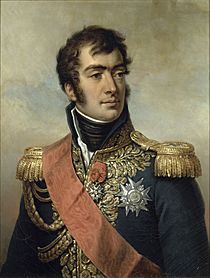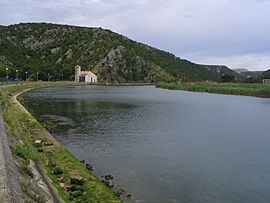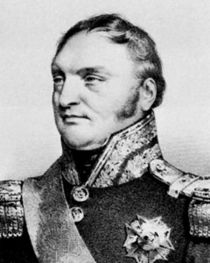Dalmatian Campaign (1809) facts for kids
Quick facts for kids Dalmatian Campaign (1809) |
|||||||
|---|---|---|---|---|---|---|---|
| Part of the War of the Fifth Coalition | |||||||
|
|||||||
| Belligerents | |||||||
| Commanders and leaders | |||||||
| Strength | |||||||
| 14,000 | 8,100–9,000 | ||||||
| Casualties and losses | |||||||
| Zrmanja River: 1,200 Pribudić: light Gračac: 300 Gospić: 1,004 |
Zrmanja River: 250 Pribudić: 1,000 Gračac: 300 Gospić: 764, 2-5 guns |
||||||
The Dalmatian Campaign was a series of battles fought in 1809. It took place between soldiers of the First French Empire, led by General Auguste Marmont, and troops from the Austrian Empire, led by Andreas von Stoichevich. These battles happened between April 30 and May 21, 1809.
At first, the Austrians pushed the French back from their positions near the Zrmanja River. But in mid-May, the French fought back strongly. Marmont's army managed to break out of Dalmatia. He then joined Emperor Napoleon's main army near Vienna with over 10,000 soldiers. This campaign was part of the larger War of the Fifth Coalition, which was a part of the Napoleonic Wars. Today, Dalmatia is a region in Croatia.
After the Austrians were defeated in Italy, Marmont started his own attack. The French beat the Austrians at Pribudić, even capturing General Stoichevich. They then moved north. Two more battles happened at Gračac on May 17 and Gospić on May 21. Marmont's army eventually reached Ljubljana (Laibach) in Carniola. He continued north to fight in the Battle of Graz and the very important Battle of Wagram.
Contents
Why the Dalmatian Campaign Happened
In April 1809, a new war began. The main armies in Italy were the French-Italian army, led by Eugène de Beauharnais, and the Austrian army, led by Archduke John of Austria. At the same time, General Marmont commanded a French army in Dalmatia.
After an earlier war ended in 1805, a peace treaty gave the areas of Istria and Dalmatia to France. Marmont had been in charge of this region since then. Napoleon thought Marmont's troops were his "finest corps." This was because they had trained well and had not fought in many bloody battles before.
Marmont's Army of Dalmatia
Marmont's army had about 14,000 soldiers. It was made up of two main groups of infantry (foot soldiers). These groups were led by Generals Joseph Hélie Désiré Perruquet de Montrichard and Bertrand Clausel. Each group had several regiments of light and line infantry.
The army also had a strong artillery (cannon) force of 78 guns. This was led by General Louis Tirlet. Marmont's chief of staff, who helped him plan, was General Jacques-Antoine-Adrien Delort.
Austrian Forces in Dalmatia
To fight Marmont, the Austrians sent General Stoichevich's brigade. On May 15, Stoichevich had about 8,100 soldiers. Most of these were infantry, including special border regiments called Grenz Infantry. He also had some cavalry (soldiers on horseback) and artillery.
Key Battles of the Campaign
Battle of Zrmanja River
Even though they had fewer soldiers, the Austrians won the first part of the campaign. From April 26 to 30, Stoichevich attacked French positions along the Zrmanja River. The Austrian border soldiers pushed the French back. Local people also helped by bothering the French as they retreated.
The French were forced back to Knin and Zadar. The Austrians lost about 250 soldiers. But they caused the French to lose 1,000 soldiers and captured 200 more. For two weeks, the fighting stopped. The Austrians could not capture Knin. Meanwhile, fighters from Bosnia and the Ottoman Empire started attacking the Austrians.
Stoichevich heard that the Archduke John had been defeated in Italy. He knew the French were moving east, so he got ready to pull his troops back. On May 15, an Austrian captain named Hrabovszky led a surprise night attack. His small group killed 100 French soldiers and captured 200 more.
Battle of Pribudić
On May 16, Marmont won an important victory against the Austrians at Pribudić. This place is about 14 kilometers (9 miles) northwest of Knin. Marmont sent some of his soldiers to attack the Austrian side while others kept them busy from the front. The attack worked, and the French took over the Austrian defenses.
The French had few losses in this battle. The Austrians, with 9,000 men, lost 200 killed, 500 wounded, and 300 to 600 captured. General Stoichevich himself was captured.
Battle of Gračac
The very next day, the two armies fought again at Gračac. Marmont said his army lost 300 soldiers in this fight. The Austrians, now led by Colonel Matthias Rebrovich, also reported losing 300 killed and wounded. They then retreated towards Gospić. Gračac is about 45 kilometers (28 miles) northwest of Knin.
Battle of Gospić
On May 21, Marmont found Rebrovich's forces near Gospić. They were set up behind the Lika River. Marmont sent one of his divisions to attack across the river. French light infantry soldiers waded across the river under fire. They took control of the high ground on the other side. They fought off many Austrian attacks.
The French brought up mountain cannons to help. Marmont noticed that the Austrian forces were separated into three groups. He attacked the middle group first. The French captured five cannons. As the Austrian center retreated, Marmont then attacked their other groups, pushing them back too.
The French lost 134 killed, 600 wounded, and 270 captured out of 11,000 soldiers. Two of their generals were wounded. The Austrians reported losing 64 killed, 500 wounded, 200 captured, and two cannons.
What Happened Next
After taking Gospić, Marmont continued his march north. He reached Trieste on May 28 and Ljubljana on June 3. On June 26, Marmont's army joined another French general's forces at the Battle of Graz. They pushed the Austrian army to the east.
Napoleon then ordered Marmont to march quickly to Vienna. Even though Marmont had won, Napoleon thought he had not moved fast enough. Many French armies were called to Vienna for a big battle. The very important Battle of Wagram was fought on July 5 and 6, 1809. By this time, Marmont's army was renamed the XI Corps.
After Wagram, Napoleon questioned Marmont about the Dalmatian campaign for two hours. Marmont was very tired after this. But to his surprise, he later found out he was going to be promoted to Marshal of France. This was a very high rank. Napoleon also sent him a letter saying, "Between ourselves, you have not yet done enough to justify entirely my choice."
Three men became marshals after Wagram. Soldiers made up a short rhyme about them:
See also
- Adriatic campaign of 1807-1814 describes British and French naval operations.
External sources
- The following two items are excellent sources for the full names of Austrian and French generals.
- napoleon-series.org Austrian Generals 1792-1815 by Digby Smith, compiled by Leopold Kudrna
- Broughton, Tony. napoleon-series.org Generals Who Served in the French Army during the Period 1789-1815






